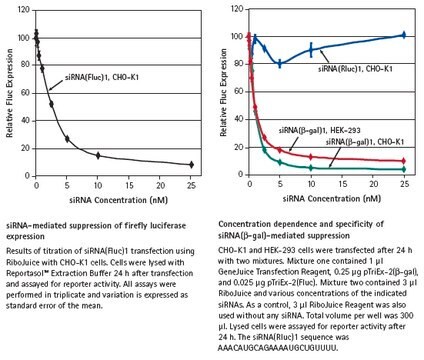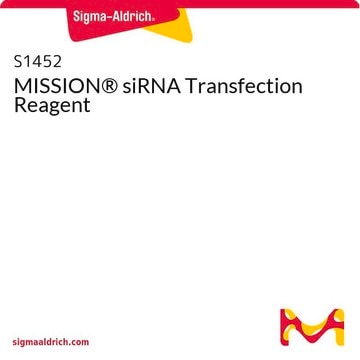Transfection efficiency is a measure of how many cells take up the DNA during the transfection process. Many transfection reagents can achieve a transfection efficiency of >90% in common cell lines. Other cell lines are hard to transfect, and require special reagents and/or techniques to achieve even a small population of transfected cells.
L3037
Escort™ III Transfection Reagent
Lipid reagent for transfecting sensitive and primary cells
Select a Size
€301.00
Select a Size
About This Item
€301.00
Recommended Products
grade
for molecular biology
Quality Level
form
liquid (aqueous solution)
usage
1 mL sufficient for 250-1000 transfections
concentration
1 mg/mL
technique(s)
transfection: suitable
storage temp.
2-8°C
General description
Application
A549
C2C12 myotubes
Cardiomyocytes (rat)
COS-7
Fibroblasts (rat)
Germ cells (male rat)
Hepatocytes (rat and hamster)
HepG2
HeLa
Jurkat
Keratinocytes (human)
Myoblasts (mouse and quail)
Myocytes (mouse)
NIH3T3
PC-12
Retinal Neurons (rat)
Tracheobronchial cells (sheep)
Features and Benefits
- Suitable for stable and transient transfection
- Optimized for a wide variety of primary cells
- Low toxicity
- Compatible with both serum and serum-free transfection protocols
- Ideal for PC-12 cells
Components
1 mg/mL total lipid in water
Note the identity of the lipids used in Escort™ III is confidential.
Caution
Principle
Legal Information
related product
Storage Class Code
10 - Combustible liquids
WGK
WGK 3
Flash Point(F)
Not applicable
Flash Point(C)
Not applicable
Personal Protective Equipment
Choose from one of the most recent versions:
Already Own This Product?
Find documentation for the products that you have recently purchased in the Document Library.
Customers Also Viewed
Articles
Transfection introduces genetic material into cells, aiding research in gene expression and cell biology.
This brief webinar provides an overview of what transfection is and the methods that are used to introduce DNA or RNA into eukaryotic cells.
Protocols
The product bulletin providin detailed use protocol for easy DNA transfection.
Product manual provides detailed protocol for easy DNA transfection.
Related Content
Browse our convenient transfection reagent selection guide to match the best reagent for your specific cell line and application needs.
-
What is transfection efficiency?
1 answer-
Helpful?
-
-
Which Escort™ transfection reagent should I use for my application?
1 answer-
Escort™ III is best for sensitive cells and primary cells, particularly PC-12 and Jurkat.Escort™ IV is excellent for mammalian cell lines, primary cells and insect cells.
Helpful?
-
-
What are the differences between the two Escort™ products?
1 answer-
Each Escort™ transfection Reagent is a different lipid formulation. These different formulations are more readily taken up by different cells, presumably by endocytosis.Escort™ III is a unique formulation of a proprietary polycationic lipid and a neutral, non-transfecting lipid.Escort™ IV is a a confidential lipid.
Helpful?
-
-
How can I determine the efficiency of my transfection?
1 answer-
Calculating transfection efficiency is very useful when optimizing transfection protocols. Transfection efficiency can be performed using a GFP-expressing plasmid. After transfection, cells are stained with propidium iodide and counted. The propidium iodide provides a count of the total cells in the population, and the GFP-expressing cells provide a count of the number of cells transfected. The transfection efficiency (%) can then be calculated by:(# GFP-expressing cells / total cell #) * 100
Helpful?
-
-
How do I choose a transfection reagent?
1 answer-
There are many guides that help you select a transfection reagent. In general, consider:The type of cell(s) you will transfectThe type of nucleic acid or protein you will introduce to the cellThe composition of your cell culture mediumThe need for stable or transient transfectionThe equipment you have availableThe other factors important to you - cost, protocol flexibility, ease of use, etc.
Helpful?
-
-
How can I increase the efficiency of my transfection?
1 answer-
Transfection efficiency is affected by many different things, including plasmid size and purity, media components present, transfection reagent selected, amount of DNA and transfection reagent used, cell density, etc. Optimizing the protocol with respect to these concerns will allow you to achieve a higher transfection efficiency. For many cell lines and transfection reagents, optimized protocols are already available.
Helpful?
-
-
Why do I see a precipitate in my cell culture after lipid-based transfection?
1 answer-
The precipitate is likely excess lipid or EDTA and will probablly not affect transfection efficiency. If your DNA plasmid is suspended in TE, be sure the concentration of EDTA is <0.3 mM, or suspend the DNA in sterile molecular biology grade water instead.
Helpful?
-
-
What is the difference between stable and transient transfection?
1 answer-
When the DNA enters the nucleus of the cell, the plasmid is replicated by the cell machinery (transient transfection). During this time, RNA is transcribed and protein translated until the plasmid DNA is lost after a few cell divisions. This expression of the plasmid DNA, mRNA, and protein is transient (temporary).In some cases, the plasmid DNA is integrated into the host cell genome. This is usually accompanied by forced expression using a selection antibiotic and sometimes a cloning step (to be sure all cells have the same integration site). Once the DNA is stable, the cell line can be frozen and used to express protein for many years. Clones may even be screened for those expressing the highest amount of protein.
Helpful?
-
-
Can antibiotics be present in the medium during transfection?
1 answer-
We recommend that no antibiotics are present during transfection. The process of transfection can make the cells somewhat more porous to allow for efficient DNA entry. During this time, antibiotics will also enter the cells more easily and the cells may show increased cell death. Wait until about 24 hours after transfection to resume the use of preventative antibiotics and/or start the use of selective antibiotics.
Helpful?
-
-
What is the Department of Transportation shipping information for this product?
1 answer-
Transportation information can be found in Section 14 of the product's (M)SDS.To access the shipping information for this material, use the link on the product detail page for the product.
Helpful?
-
Active Filters
Our team of scientists has experience in all areas of research including Life Science, Material Science, Chemical Synthesis, Chromatography, Analytical and many others.
Contact Technical Service











